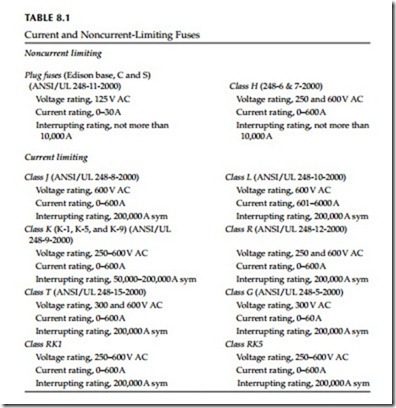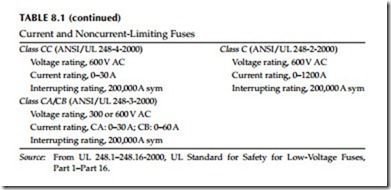Fuses
Two basic families of fuses are current limiting and noncurrent limiting. The current-limiting fuse melts and extinguishes the arc in a half-cycle or less. The noncurrent-limiting type may melt in less than a half-cycle when subjected to very high values of short-circuit current, but is unable to extinguish the arc in a half-cycle. Since the arc is a flexible conductor, the noncurrent-limiting-type fuse will allow the short-circuit current to reach its maximum peak value. The current-limiting type of fuses are constructed with mechanisms to extinguish the arc, thereby preventing the short-circuit cur- rent from reaching its maximum peak value. The fuses are used in conjunc- tion with circuit breakers, motor starters, disconnect switches, and the like to provide protection similar to the circuit breaker overcurrent trip devices. However, fuses have fixed time–current relationships and therefore do not provide the same flexibility as the overcurrent relationships and therefore do not provide the same flexibility as the overcurrent trip devices. Fuses cannot open and close a circuit by themselves. They must be combined with some supplementary device, such as a disconnect switch, a circuit breaker, or a contactor. Fuses can be divided into medium- and low-voltage fuses.
Low-Voltage Fuses
Low-voltage fuses are divided into four broad categories:
1. Cartridge fuses, designed for the protection of circuits
2. Plug fuses, designed for the protection of circuits
3. Supplementary fuses, designed for the protection of small appliances, electronic equipment, and the like
4. Special fuses, designed for the protection of electrical equipment such as capacitors, welders, and rectifiers
The standards applicable to these fuses are NEMA FU-1 dated 2002, and ANSI/UL 248-1 through 248-15 dated 2000. In particular, the ANSI/UL 248-8 dated 2000 covers the class J fuses and ANSI/UL 248-10 dated 2000 covers class L fuses. Furthermore, UL has classified fuses as current limiting and non- current limiting, as shown in Table 8.1. Further, classes R, J, L, T, and CC fuses
are designated as branch circuit fuses suitable for protection of distribution systems, wiring, or equipment.
Because fuses are single-phase interrupters, they provide good protection for single-phase circuits. However, for multiphase circuits, these single-phase interrupters can cause problems such as single phasing, backfeeding, and ferroresonance. Single phasing can be detrimental to motors owing to the flow of negative-sequence currents, which can cause excessive heating of the motor rotor, causing motor failure or reducing its normal life. The degree of motor life reduction is a function of motor temperature and elapsed time between single-phase occurrence and motor de-energization.
The term back feeding is used to describe the condition when fault current continues to flow from the remaining energized phases, most probably at a reduced value owing to the additional impedance that has been inserted in the current path. The degree of fault current reduction will determine the time of response of the fuses in the remaining phases. As fuse interrupting time increases, the degree of damage also increases. Today’s switchgear designs employing fuses as overcurrent protective devices use anti-single phase protection features. The anti-single phase feature in the fused switch- gear open all three phases due to a single fuse blowing, thereby averting the adverse effects of single phasing discussed earlier.

